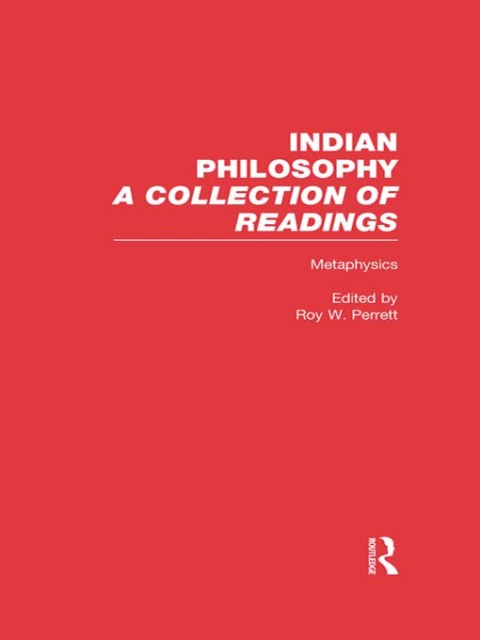Description
Efnisyfirlit
- Cover Page
- Half Title Page
- Series Contents
- Title Page
- Copyright Page
- Contents
- Series Preface
- Series Introduction
- Volume Introduction
- Ontological problems in nyāya, buddhism and jainism a comparative analysis
- Notes
- Bibliography
- Vedāntaparibhāṣā as systematic reconstruction
- I
- II
- The nyayā-vaiśeṣika theory of universals
- I. Statement OF THE THEORY
- II. OBJECTIONS TO THE THEORY BY OTHER SCHOOLS
- III. RESTRICTIVE CONDITIONS FOR UNIVERSALS
- Notes
- Bibliography
- Review article more things in heaven and earth
- Notes
- Negative Facts and Knowledge of Negative Facts
- Introduction
- I Negative FACTS
- II ABSENCES AND KNOWLEDGE OF ABSENCES
- Notes
- References
- Mereological considerations in vasubandhu’s “proof of idealism”* (Vijñaptimātratāsiddhiḥ)
- Appendix: Viṃśatikā, 11–15; The Proof of Idealism22
- i. Rejection of possible alternatives to idealism (v. 11).
- ii. Refutation of atomism (v. 12–14).
- iii. Refutation of the doctrine of simple, extended wholes (v. 15).
- iv. Conclusion
- Notes
- Causality in the Nyāya-Vaiśeṣika school
- Notes
- An ontology of concbete connectors1
- Ethics And ethics and the moral life1
- Dependent arising and the emptiness of emptiness: why did nācārjuna start with causation?
- 1 Introduction
- 2 Chapter 1—Examination of Conditions
- 3 Chapter 24 —Examination of the Four Noble Truths
- 4 The Emptiness of Emptiness
- 5 Simple Emptiness versus the Emptiness of Emptiness
- 6 The Importance of Causation
- 7 Antimetaphysical Pragmatism in Buddhism
- Appendix: TRANSLATION OF CHAPTERS 1, 2, AND 24 OF THE MŪLAMĀDHYAMIKAKĀRIKĀ (TRANSLATED FROM THE TIBETAN TEXT)
- Chapter 1—Examination of Conditions
- Chapter 2—Examination of Motion
- Chapter 24 —Examination of the Four Noble Truths
- Notes
- References
- Freedom and Determinism from an Indian Perspective
- Reductionist and nonreductionist theories of persons in indian buddhist philosophy
- Introduction
- Vasubandhu’s Statement of his theory of persons
- Seeing Oneself as a Self and the Cause of Suffering
- Vasubandhu’s Basic Argument For This Theory
- (i) The Selfless Persons Argument
- (ii) The Continuum Persons Argument
- Avoidance OF THE TWO EXTREMES AND THE MODE OF EXISTENCE OF PERSONS
- Notes
- Self-construction in buddhism
- I
- II
- III
- Buddhist reductionism
- Notes
- References
- The Mīmāṃsā theory of self-recognition
- I
- II
- Abbreviations
- Notes
- I Touch What I Saw
- 0. Introduction: Real ism-links
- 1. The Method: Good old Nyāya Wine in a Fregean Bottle
- 2. The Ego and the It
- 3. Backtracking: Someone In Here Entails Something Out There
- 4. Conclusion: Externalism without Qualms
- Dehātmavāda or the body as soul Exploration of a possibility within nyāya thought
- Translator’s Notes
- Notes and References
- An eccentric ghost in the machine: Formal and quantitative aspects of the Sāṁ khya-Yoga dualism
- Mind/Consciousness Dualism in Sāṅkhya-Yoga Philosophy
- 1 Introduction
- 2 Sāṅkhya-Yoga Dualism
- 3 The Distinction Between Consciousness and Content
- 4 Cartesianism and the Chinese Room
- 5 Conclusion
- References
- The Self in Advaita Vedānta
- I. Paramātman
- II. Jīvātman
- 1. The Phenomenal Status of the Jīva
- 2. The Nature of the Jīvātman
- III. Fruitfulness of the Advaitic Analysis
- The Concept Of The Absolute And Its Alternative Forms
- Acknowledgments





